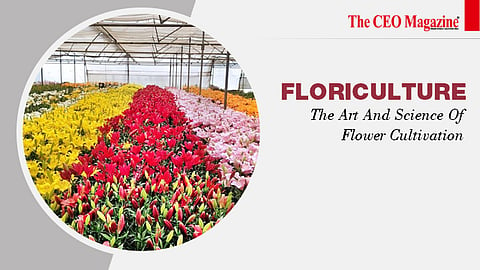
- News
- Women
- Magazine
- IndustryIndustry
- InsightsInsights
- Success Stories
- PublishPublish
- ContactContact
- Media KitMedia Kit

Floriculture: The Art And Science Of Flower Cultivation
Floriculture cultivates flowers and ornamental plants for use in gardens, landscapes, and the florist industry. It is both an art and a science, as it involves the careful selection and cultivation of plants, as well as the design and arrangement of flowers for aesthetic purposes.
Floriculture has a rich history that dates back thousands of years. The ancient Egyptians, Greeks, and Romans all cultivated flowers for their beauty and symbolic meaning.
During the Renaissance, flowers were used in art and literature as symbols of love, beauty, and purity. In the 17th and 18th centuries, flower gardens became popular in Europe, and floriculture as a commercial industry began to emerge.
Today, floriculture is an important industry, with millions of people worldwide enjoying the beauty and benefits of flowers. In addition to their aesthetic appeal, flowers are used in many ways, including for medicinal purposes, as a source of food, and for their fragrance in perfumes and other products.
Many different types of flowers are cultivated for use in floriculture. Some of the most popular include roses, tulips, lilies, daisies, and orchids. Each type of flower has its own unique characteristics and requires specific growing conditions.
Cultivating flowers is both an art and a science, requiring careful attention to the needs of each individual plant. Factors such as light, temperature, water, and soil quality all play a role in the growth and development of flowers. In addition, pest and disease control is essential to ensure that the plants remain healthy and produce high-quality flowers.
Designing with flowers is a key aspect of floriculture, as the arrangement and display of flowers can greatly enhance their beauty and impact. Florists and floral designers use various techniques and principles to create beautiful arrangements, including colour theory, texture, and balance.
Sustainable floriculture is an important aspect of the industry, as it involves using practices that minimise the environmental impact of flower cultivation. This can include using organic fertilisers and pesticides, conserving water, and reducing energy use.
Floriculture is a fascinating and important industry that combines the art and science of flower cultivation. From the history of flower cultivation to the importance of sustainable practices, there is much to learn about this fascinating field.
Whether you are a gardener, a florist, or simply someone who appreciates the beauty of flowers, floriculture offers something for everyone.
Follow us on Google News
